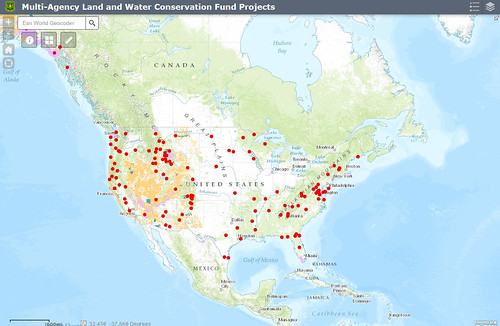
United States Forest Service LWCF projects and many other Government LWCF projects can be viewed in the new interactive map.
There is a Federal program that you may not have heard of, but it is responsible for conserving millions of acres of recreational and conservation lands for Americans to enjoy, and it helps fund local parks, provide access to rivers and trails, and preserve wildlife habitat in every state in the Union. This program is the Land and Water Conservation Fund (LWCF) and each year, the Department of the Interior and Department of Agriculture request funding from Congress to support grants to states and high priority federal recreational and conservation investments. Locating and learning about these special places is now easier than ever through a new interactive map. The map enables everyone to explore the 173 public projects proposed for investment in 43 states, including important waterfowl nesting habitat in the Prairie Potholes, battlefields and historic sites from Pennsylvania to Washington, scenic vistas in iconic locations like Maine’s Acadia National Park, and recreation sites in national monuments in California and Arizona.
Land and Water Conservation funds secure access for the American public to their Federal lands. For 50 years, the law has been one of the most successful programs for recreation and conservation in our history. LWCF has provided funding to local communities that supported the construction of more than 40,000 city parks, hiking and biking trails, and boat ramps, and access to thousands of acres of fishing and hunting and important wildlife habitat.
The Land and Water Conservation Fund enables federal land managers to invest in acquisitions to better meet public recreation access needs by working with willing landowners to provide better public access so that the public has more areas to hike, hunt, and fish. Of the projects shown on the map, over 90 percent would provide increased public access to our public lands. For example, some of the funding will help ensure safe access for the Continental Divide National Scenic Trail, one of the crown jewels of the National Trails System. With support from LWCF investments, Federal agencies and local partners are protecting the majority of the 3,100-mile route, but portions remain where hikers and horseback riders must travel along state highway shoulders.
The LWCF also helps preserve our nation’s history by acquiring historically important lands that are in imminent danger from industrial or residential development. The President’s Budget includes proposed funding to acquire an inholding in Gettysburg National Military Park and would protect a parcel of land containing the remains of McAllister’s Mill, the only documented Underground Railroad site within the park boundary.
The Fund invests in healthy ecosystems, which delivers cost savings for the Federal government, local communities and taxpayers. Timely acquisition of important natural areas today can help avoid much higher costs to taxpayers in future years by protecting drinking water supplies, important species habitat, recreational and cultural sites, and other natural resources with economic value to the public. Proposed projects in North Carolina’s Pisgah and Uwharrie National Forests, Arizona’s Saguaro National Park, and Alaska’s Lake Clark National Park and Preserve would deliver immediate and long-term savings in administrative and avoided firefighting costs.
The Land and Water Conservation Fund will expire at the end of September, unless Congress votes to reauthorize it. President Obama asked this Congress to reauthorize the law and fulfill the original intent of the law by permanently guaranteeing that the full $900 million in oil and gas revenue that companies transfer each year to the Land and Water Conservation Fund under the law actually goes to support these projects. Congress can accomplish this goal by guaranteeing mandatory funding for the LWCF to ensure that local communities, states, and partnering land owners are not left without a critical source of funding for hundreds of projects waiting in the pipeline for grants and federal funding.
America’s public lands – from national forests to city parks to historic battlefields – are hallmarks of our Nation’s rich culture, history, and natural diversity. The Land and Water Conservation Fund gives us the opportunity to conserve them to enjoy now and into the future.
No comments:
Post a Comment
Note: Only a member of this blog may post a comment.